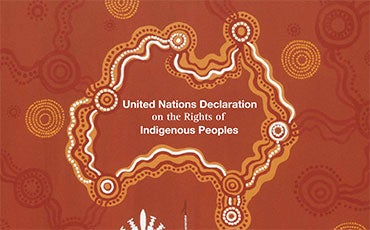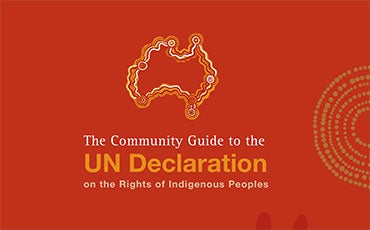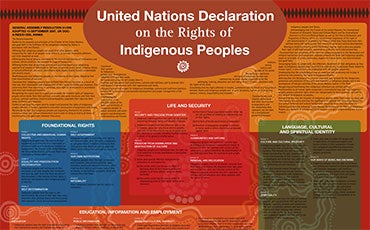UN Declaration on the Rights of Indigenous Peoples

The Declaration is the most comprehensive tool we have available to advance and protect the rights of Aboriginal and Torres Strait Islander peoples. I use the Declaration as my guide as Social Justice Commissioner.
- June Oscar AO, Aboriginal and Torres Strait Islander Social Justice Commissioner
GET IT
Declaration Abridged Community Guide
Declaration booklet
Declaration poster
KNOW IT
The Declaration covers all areas of human rights as they relate to Indigenous peoples. This includes the fundamental and foundational human rights of Indigenous peoples which can be categorised into four key principles:
- self-determination
- participation in decision-making
- respect for and protection of culture
- equality and non-discrimination
These four principles provide guidance on how Aboriginal and Torres Strait Islander communities, governments, civil society and the private sector can apply the Declaration to help fully realise the human rights of Aboriginal and Torres Strait Islander peoples.
Read the declaration on the Australian Human Rights Commission website
Recent articles
- Incorporating UNDRIP into Australian law would kickstart important progress - June Oscar AO (13 September 2021)
- Reflections: Our health, our way - June Oscar AO (7 August 2019)
- Narrm Oration - June Oscar AO (16 November 2017)
USE IT
Using and promoting the Declaration can help bring about positive change. One of the best ways Aboriginal and Torres Strait Islander people can do this is by using the language of rights when talking about the issues in their communities. Using the Declaration reminds all levels of government of our rights. The Declaration can also be used in other ways, including:
- by organisations adopting the standards in the Declaration in policy statements or guidelines
- it can be used in law reform submissions to governments
- it can be referred in letters to those who represent Indigenous peoples in all levels of government and to government officials
- it can be referred to in court matters
- it can be used in media campaigns
- it can be used to strengthen and guide campaigns about issues reflected in the Declaration
- to campaign for constitutional recognition of our rights – both at the national level, and also in recognising the Declaration in the constitutions of our institutions and organisations.
I think people should use the Declaration at every opportunity. For example:
- If you are writing to government quote articles of the Declaration.
- If you’re involved in health quote the health article.
- If you are involved in native title or land rights quote the lands, territories and resources articles.
- If you are in education quote the articles about education and language.
- If you are on about political organisation talk about self-determination and our right to be autonomous and govern ourselves.
For any aspect of Aboriginal or Torres Strait Islander life there is something in the Declaration that you can use and utilise to reinforce your arguments and what you and your mob are trying to do.
Talking rights – Using the Declaration - (Mick Dodson)
Using your rights – Referring to the Declaration
We can use the Declaration in any work we are doing. When writing submissions, letters or in the media the best way to refer to the Declaration is to quote the relevant article. The following is an example:
Example:
Article 18 of the UN Declaration on the Rights of Indigenous Peoples outlines the right of Aboriginal and Torres Strait Islander peoples to actively participate in decisions about matters that affect them. It states:
Indigenous peoples have the right to participate in decision-making in matters which would affect their rights, through representatives chosen by themselves in accordance with their own procedures, as well as to maintain and develop their own indigenous decision-making institutions.
To ensure consistency with this standard, an effective system must be established to actively engage Aboriginal and Torres Strait Islander peoples in the decision-making process.
Australia’s support for the Declaration does not make it law in Australia. However, we can still use the Declaration to lobby for reforms to laws, policies and programs to ensure they are consistent with standards of the Declaration.
The Declaration is given weight by the following factors:
- It is sourced from existing international human rights law
- It is widely supported by both governments and Indigenous peoples globally
- It is the result of a democratic and open process
- It uses language similar to a treaty.
Answers to Frequently asked questions
- Does the Declaration create new rights?
- What is the Declaration used for?
- What is the value of the Declaration to Aboriginal and Torres Strait Islander peoples?
- Does the Declaration elevate customary law over Australian law or individual rights?
- Does the Declaration mean that Indigenous people can set up separate education systems?
- Does 'self-determination' give Indigenous people the right to secede?
- Does the Declaration give Indigenous peoples greater rights to land beyond those specified in the Native Title Act?
- Will the Declaration have an impact on public policy and confer rights upon one sector of the Australian community to the exclusion of all others?
- What happens in cases where there are different interpretations of rights between government and Indigenous Australians?




